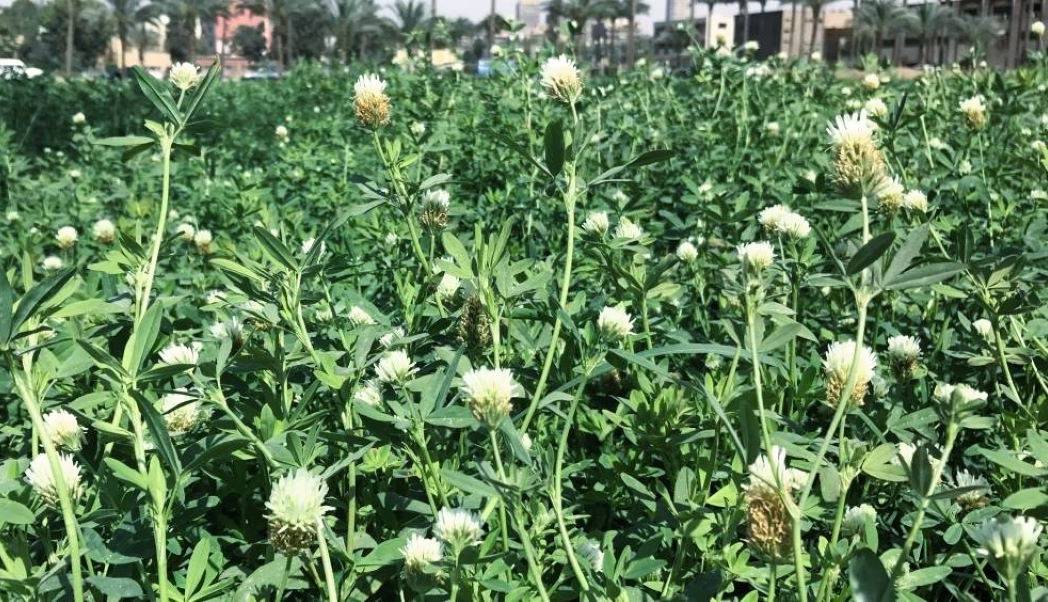
Trifolium Alexandrinum, commonly known as Berseem Clover, is an important annual clover species predominantly cultivated as a fodder crop in irrigated sub-tropical regions. This leguminous crop holds significant agricultural importance, particularly as a winter crop in regions like Egypt, where its cultivation dates back to ancient times. Berseem Clover was introduced into northern India in the early 19th century and has found its place in various regions globally, including the United States, Europe, China, and Australia.
Characteristics and Cultivation of Berseem Clover
Berseem clover typically grows between 30 to 100 cm tall, featuring erect or ascending stems. Two primary types exist: single-cut and multi-cut varieties. Single-cut varieties, exemplified by 'Balady', have a high growing point but display poor recovery post-harvest. On the other hand, multi-cut varieties like 'Frosty' possess a lower growing point. It enables multiple harvests from a single sowing.
Adaptability and Frost Tolerance
Generally sensitive to frost, berseem clover should be planted after the risk of frost has diminished. However, 'Frosty' berseem, developed by Grassland Oregon, Inc. and released in 2016, exhibits remarkable resilience, capable of withstanding temperatures as low as 5 °F (-15 °C).
Diverse Applications of Berseem in Agriculture
Berseem clover offers multifaceted utility in agriculture. As a forage crop, it can yield up to 8 tons of forage in a single growing season, comparable in quality to alfalfa. Moreover, it serves as an effective green manure crop, suppressing weeds and enriching the soil with nitrogen, providing up to 280 lbs./acre to subsequent crops.
Potential of Fodder Crops
Berseem clover stands out as highly nutritious fodder, particularly valued for winter livestock feed due to its repeated cutting capability. With a crude protein content of 17%, crude fiber content of 25.9%, and 60-65% Total Digestible Nutrients (TDN), it offers a balanced diet for livestock. However, its growth is constrained during severe cold or frosty weather, thriving best in mild temperatures and medium to heavy soils with moderate salinity.
Improving Crop Productivity
The inclusion of berseem into cropping systems presents opportunities for enhancing yield and income, particularly in mustard-based cropping systems. Demonstrations conducted in selected villages of Morena District, Madhya Pradesh, during 2016-19 showcased the potential of relay cropping berseem in mustard within a pearl millet-based system.
In the relay cropping system, berseem (variety - Wardan) is sown after the establishment of mustard, with recommended agricultural practices followed diligently. Results from these demonstrations revealed significant yield increases in pearl millet and mustard, ranging from 14 to 27% and 11 to 26%, respectively, compared to fields without relay cropping. Moreover, the overall productivity of the pearl millet equivalent system surged from 50 to 73% with relay cropping, demonstrating its economic viability.
Economic Analysis
Comparative analysis of cultivation costs and net returns between fields with and without relay cropping showcased favorable economic outcomes. While cultivation costs in demonstration fields ranged from Rs. 57,220 to 76,740 per hectare, net returns soared from Rs. 63,170 to 1,00,670 per hectare, highlighting the profitability of integrating berseem into cropping systems.
Soil Fertility and Sustainability
Apart from economic gains, relay cropping berseem in mustard-based systems contributes to soil fertility enhancement. Through nitrogen fixation and the incorporation of residues, berseem clover aids in improving soil organic carbon levels, supporting microbial activity, and replenishing essential nutrients. This approach not only enhances productivity but also fosters sustainable agricultural practices, particularly in regions reliant on groundwater or canal water.
Its integration into cropping systems, especially in relay cropping arrangements, offers farmers opportunities to maximize yields, income, and soil fertility. With careful implementation and adherence to recommended practices, berseem clover can play a pivotal role in transforming agricultural landscapes towards greater resilience and prosperity.















